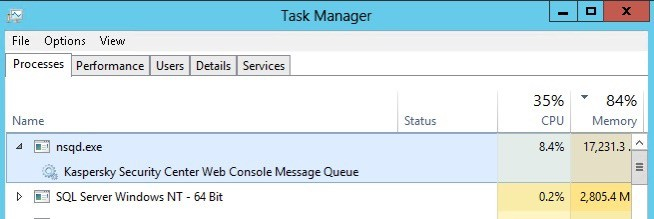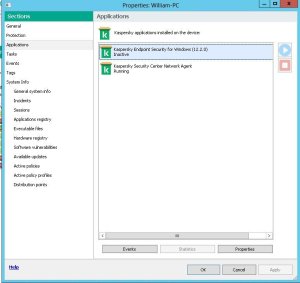
LouisLewis
Members-
Posts
27 -
Joined
-
Last visited
Everything posted by LouisLewis
-
Change activation email (my Kaspersky account)
LouisLewis replied to LouisLewis's topic in My Kaspersky
Thank you for responding. In this case, it's just the Kaspersky Standard edition for individuals. Our customers are having issues with the activation email, and they're asking if there's a way to change it. -
Hello, I'm unsure how to phrase the subject. In case I have this activation code with someone else's my Kaspersky account. Is there a way for me to transfer it to my own my Kaspersky account?
-
Hello, I am currently experiencing an issue where the nsqd.exe file (Kaspersky Security Center Web Console Message Queue service) is consuming 17GB of RAM on my computer, causing it to freeze. Has anyone encountered a similar situation? Is there a way to resolve this, or do I need to uninstall the KSC Web Console? Thank you.
-
A few days ago, while I was trying to fix the connection error to Kaspersky Endpoint Security (KES), I encountered an issue related to login credentials. According to my findings in the Event Viewer, I changed the login account to a local administrator account using klsrvswch.exe. After completing this process, I was able to log back into KES through the MMC console. However, when I tried to log in via the Web Console, I received an "invalid credential" error. I have double-checked the password and attempted to log in again, but it still doesn't work. Is there a way to resolve this issue?
-
So, we don't have any way to prevent users from closing the Kaspersky application, even on the Windows version? But what I meant is that the client doesn't completely uninstall the application, it just exits (becomes inactive), but from the server side, I can't reactivate it myself (by clicking the start button). These client machines I mentioned earlier only open ports 13000 and 15000. Could this be the reason why I can't start the application from the server? Can we set up an admin password to prevent clients from closing the application?
-
Hello, I followed your instructions and successfully installed it on machines using the Windows operating system. However, I'm encountering a slight issue with machines running MacOS. With Windows machines, when I create a stand-alone installation package, there's an .exe file for installation. But for the MacOS installation package, I end up with 2 .sh files after creating it. I'd like to know if there's a way for me to install it locally on a MacOS machine. I've gone through the documentation, but it's still quite unclear to me.
-
I'd like to inquire a bit further. Because currently the server won't be able to pool client machines for remote KES installation, am I correct in assuming that I will need to create a stand-alone installation package from the KSC server and then manually install it on the clients? In the case where I have opened port 13000 on both sides and port 15000 on the KSC server, the network agent from the client machines will automatically connect to the KSC, is that correct? Thank you,
-
Thank you for your assistance. Based on what I've read in the documents you provided above, if we only open port 13000 on the KSC server, would that be sufficient? I noticed that port 13000 is responsible for communication between the client and server. Because the number of client machines at this time is also quite small. Thank you.
-
Hello, perhaps my title doesn't quite accurately reflect this situation. Our customers currently have the following server setup: 5 servers located in an office in Vietnam, 3 AWS servers (1 in Asia, 1 in the EU, 1 in China), and 1 server placed in a different office. They plan to install Kaspersky Security Center on the AWS server in the EU. However, the machines located in the office in Vietnam are currently using Private IP addresses and are unable to ping back and forth between the client and the server (the server located in the Vietnam office can still remote desktop to the AWS EU server). I would like to inquire in this scenario, if only ports (KSC used) are opened, will the server and client be able to communicate with each other? (Ping protocol is blocked) Many thanks,
-
I tried to delete unused keys in the Kaspersky License tab, but I couldn't find a place to delete them. I attempted to delete them through the Web Console, but it still didn't work. I want to ask about remote KSWS solution deletion, is it similar to removing the entire KSWS from the client machine, or is it just removing the client from the Manage Device and Unassigned Device sections?
-
Hi Elvin, I apologize for bothering you again. My current issue is that I have added a key and unchecked the "Use as an additional key" option, but it seems that everything is not going smoothly. The Task report shows "Completed Successfully," but when I checked the machines, they still haven't received the key!? I checked each machine by selecting the client machine -> Properties -> Applications -> KSWS -> Properties -> License keys, but the License keys table is completely empty. I recreated the Task and started over, but it didn't help. Have you ever encountered a similar situation?
-
Thank you so much, it's been very helpful to me. I have one more question for KSWS regarding transferring the license key from this machine to another. In the event of a malfunction (data wiped), will the activated key on the machine be automatically removed? Or is there a way to revoke the key from the KSC server? Currently, I want to apply a new key for 11 client machines (3 of them haven't been activated, while the others are using different keys). After running the 'Task add key,' only the 3 new machines received the key (I checked in the 'Kaspersky Licenses' section on KSC). Thank you once again.
-
You are right, I have read it in the document "Kaspersky Endpoint Security supports core components of the application on computers running the Windows operating system for servers. You can use Kaspersky Endpoint Security for Windows instead of Kaspersky Security for Windows Server on servers and clusters of your organization (Cluster Mode)" But I still have one question, is there anything noteworthy about the Security for Windows Server version? Have you tried using it? Please give me some advice. Thank you. And with the KES Select license that my friend currently has, is it the best option to use the Endpoint for Windows version?
-
Apologies, the title might still be a bit vague as I'm not sure how to express it properly. Currently, my friend has purchased a Kaspersky Endpoint Security - Select license. He has installed Kaspersky Security Center (KSC) on the management server. However, on the client machines, he has installed the Security for Windows Server package (In my case, I only used the Endpoint for Windows package before). Additional information is that both my client servers or his servers are using the Windows Server operating system. I want to ask if it is correct for me to only install the Endpoint for Windows version on my servers? And is it correct in terms of the license for my friend to use the Security for Windows Server version? (I also don't see a manual activation option for servers like the Endpoint for Windows version). And the Task section for these two versions in KSC is also different; I don't see the Scan task for Security for Windows Server. Am I missing any part? On the server with Security for Windows Server installed, my friend encountered a minor issue where he had to disable the Local Server (TCP) blocking in order to perform scans, even though he had added the IP range of the scanning machine to the exclusion list. I would like to ask if there is any way to resolve this issue? Or have we misconfigured something? These are some issues I am currently facing and I hope you guys can help me overcome these issues. English is not my native language, so some parts may be difficult to understand. Thank you for your understanding and support. thank you very much.
-
Cannot discover devices in local network
LouisLewis replied to LouisLewis's topic in Kaspersky Security Center
Thank you very much, it solved my problem I changed the name to my server IP using the klmover command and now it works -
Cannot discover devices in local network
LouisLewis replied to LouisLewis's topic in Kaspersky Security Center
First, Thanks for the advice I checked and found the Administration Server Address is correct. But when I select "send heartbeat" I get the message "connection has been terminated" utility - klnagchk returns synchronization request values all return 0 like this All TCP 13000, 14000 and UDP 15000 ports are allowed on both server and client -
Hi, Currently my KSC server (10.0.0.254) is managing devices in the same ip range I want to install KES on target device with ip 10.0.2.40. I have configured firewall, can ping from KSC to target machine and from target machine to KSC machine. But when I discover device from KSC, the server still cannot find the target device. I've tried installing using stand-alone installation package but still not able to connect to KSC. Am I missing out on something? Please let me know if there is any way to fix it. Thank you
-
Cannot connect to Pulse Secure VPN
LouisLewis replied to LouisLewis's topic in Kaspersky Endpoint Security for Business
What I found was that KES was somehow blocking the PSC VPN. I've tried turning off the firewall, but nothing seems to change. But I haven't tried setting exceptions for the application yet, hope it will work. Thanks for the advice -
Hello everyone, My client uses the Pulse Connect Secure software to establish a VPN connection, but they're getting an "endpoint is not compliant" message. Is this a compatibility error? And is there any way to solve it? Please let me know The endpoint installed on the computer is Kaspersky Endpoint Security 11 Thank you





